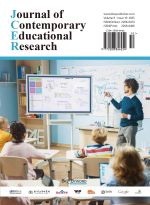Exploration of the Teaching Reform of Integrating Marine Knowledge and Basic Analog Electronic Technology Course Based on BOPPPS
Abstract
This paper focuses on the problems existing in the teaching of analog electronic technology courses, and puts forward the teaching reform idea of combining marine knowledge with the course content. Based on the BOPPPS teaching model, specific teaching links are designed, and the teaching practice is carried out as an example of a low-power, high-precision microprocessor development project. The practical results show that the teaching reform improves students’ learning interest and participation, cultivates students’ engineering practice and innovation abilities, and provides a useful reference for the teaching reform of related courses.
References
Savery JR, 2006, Overview of Problem-Based Learning: Definitions and Distinctions. Interdisciplinary Journal of Problem-Based Learning, 1(1): 9–20.
Barrows HS, 2000, Problem-Based Learning Applied to Medical Education. Springfield: Southern Illinois University School of Medicine, 22(4): 12–63.
Hmelo CE, 1998, Problem-Based Learning: Effects on the Early Acquisition of Cognitive Skill in Medicine. Journal of the Learning Sciences, 7(2): 173–208.
Hmelo-Silver CE, 2004, Problem-Based Learning: What and How Do Students Learn? Educational Psychology Review, 16(3): 235–266.
Walker A, Leary H, 2009, A Problem-Based Learning Meta-Analysis: Differences Across Problem Types, Implementation Types, Disciplines, and Assessment Levels. Interdisciplinary Journal of Problem-Based Learning, 3(1): 12–43.
Strobel J, Barneveld AV, 2009, When is PBL More Effective? A Meta-Synthesis of Meta-Analyses Comparing PBL to Conventional Classrooms. Interdisciplinary Journal of Problem-Based Learning, 3(1): 4.
Kaufman DM, Mann KV, 1996, Comparing Students’ Attitudes in Problem-Based and Conventional Curricula. Academic Medicine, 71(10): 1096–1099.
Rodriguez CA, Fernandez-Batanero JM, 2017, Application of a Problem-Based Learning in University Students of Irrigation Engineering. Journal of Science Education, 18(2): 90–96.
Asghar A, Ellington R, Rice E, et al., 2012, Supporting STEM Education in Secondary Science Contexts. Interdisciplinary Journal of Problem-Based Learning, 6(2): 85–125.
Lanlan F, Wenfang MA, Jianbei T, et al., 2017, Application of BOPPPS on the Teaching of Traditional Chinese Medicine Identification. Anhui Medical and Pharmaceutical Journal, 21(8): 2–5.
Wang S, Xu X, Li F, et al., 2021, Effects of Modified BOPPPS-Based SPOC and Flipped Class on 5th-Year Undergraduate Oral Histopathology Learning in China during COVID-19. National Library of Medicine, 21(1): 540.
Song Y, Yeom J, 2023, The Mediating Effect of the Online Class Method and the Moderating Effect of Class Burden in the Relationship between Online Class Readiness and Class Satisfactions. The Korean Society of Culture and Convergence, 45(3): 145–156.
Shih WL, Tsai CY, 2020, Effect of Flipped Classroom with BOPPPS Model on Learners’ Learning Outcomes and Perceptions in a Business Etiquette Course. The Asia-Pacific Education Researcher, 29(1): 257–268.
Ma X, Ma X, Li L, et al., 2021, Effect of Blended Learning with BOPPPS Model on Chinese Student Outcomes and Perceptions in an Introduction Course of Health Services Management. AJP Advances in Physiology Education, 45(2): 409–417.
Chen CY, Shi XW, Yin SY, et al., 2024, Application of the Online Teaching Model Based on BOPPPS Virtual Simulation Platform in Preventive Medicine Undergraduate Experiment. BMC Medical Education, 24(1): 1–11.
Lou SJ, Dzan WY, Lee CY, et al., 2014, Learning Effectiveness of Applying TRIZ-Integrated BOPPPS. International Journal of Engineering Education, 30(5): 1303–1312.
Pawson E, Fournier E, 2006, Haigh M, et al., Problem-Based Learning in Geography: Towards a Critical Assessment of its Purposes, Benefits and Risks. Journal of Geography in Higher Education, 30(1): 103–116.
Gwee CE, 2009, Problem-Based Learning: A Strategic Learning System Design for the Education of Healthcare Professionals in the 21st Century. Kaohsiung Journal of Medical Sciences, 25(5): 231–239.
Jia F, Wang M, Lv Q, et al., 2025, Application of the BOPPPS-CBL Model in Emergency Chest Pain Management Teaching for Resident Physicians: A Randomized Comparison. BMC Medical Education, 25(1): 378–378.
Giustini D, 2009, Utilizing Learning Theories in the Digital Age: From Theory to Practice. Journal of the Canadian Health Libraries Association, (30): 19–25.
Wunderlich I, 2015, Bridge-Ins, About Building Bridges at the Beginning of a Language Lesson. UPED, (5): 114–121.
Poon J, 2013, Blended Learning: An Institutional Approach for Enhancing Students’ Learning Experiences. Journal of Online Learning Teaching, (2): 271–288.
Fu X, Zhang K, Jiang X, et al., 2024, Innovation and Practice of Teaching Methods in Digital and Adaptive Learning: Taking Communication Engineering Major as an Example. Journal of Contemporary Educational Research, 8(9): 32–39.

